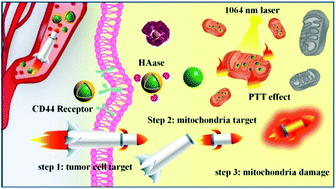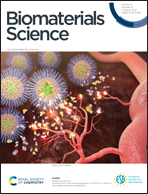Cascade targeting tumor mitochondria with CuS nanoparticles for enhanced photothermal therapy in the second near-infrared window†
Abstract
Photothermal therapy, assisted by local heat generation using photothermal nanoparticles (NPs), is an emerging strategy to treat tumors noninvasively. To improve treatment outcomes and to alleviate potential side effects on normal tissue cells, utilizing the optically transparent second near-infrared (NIR-II) window and actively targeting tumors are critical. Considering that mitochondria are heat sensitive and play an important role in the up-regulation of metabolic activity in tumor cells, herein we report a cascade targeting scheme that enables active photothermal ablation of tumor mitochondria. First, NIR-II absorbing CuS NPs were surface modified with the mitochondria targeting moiety (3-carboxypropyl) triphenylphosphonium bromide (TPP) and then shielded with CD44 targeting hyaluronic acid, which will only expose TPP upon reaching the tumor sites. This allowed over 90% CuS NP enrichment at tumor mitochondria, and as a result, significantly improved tumor cell photothermal ablation was observed at the cellular level. An in vivo study demonstrated enhanced tumor uptake and improved tumor growth suppression by using these cascade targeting CuS NPs as NIR-II photothermal agents.



 Please wait while we load your content...
Please wait while we load your content...